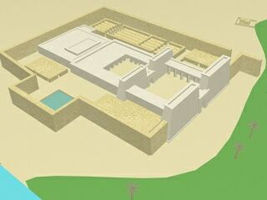| Homepage | Timeline | Maps | A-Z index | Learning |
Religious architecture in ancient Egypt
What is a temple in ancient Egypt?
In ancient Egypt sacred space is set aside for a building to house the cult of three types of being:
|
right: reconstruction of the temple to Merenptah, Thebes, West Bank |
 |
In each case the focus of the building is an image of the deity, ruler, or individual sustained by the cult. This image is a physical vessel through which the deity, ruler or individual can receive cult; it is not itself the deity or person: see the page on the ritual of opening the mouth and eyes of a statue.
The plan and elevation of cult buildings varies greatly over place and time: see the page on the variety of forms.
In general the cult precinct grows in scale and the earlier mud-brick buildings are increasingly replaced by stone elements and then building complexes entirely built in stone: again, this transformation in material varies over place and time. For the general pattern, see the page on the spread of the 'formal temple' across Egypt over time.
Most well-preserved temple buildings from ancient
Egypt are located in southern Upper Egypt, from Dendera to the First Cataract,
and date to the New Kingdom and Ptolemaic to early Roman Periods. These follow
a fairly standard plan, but it is not certain what proportion of temples across
Egypt would have shared that plan and elevation.